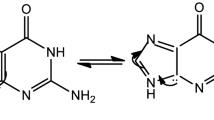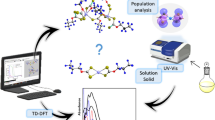Abstract
The host–guest interactions between hemicucurbit[6 and 12]urils and o-, m-, and p-aminophenols have been investigated by means of 1H NMR spectrometry, fluorescence emission spectroscopy, and isothermal titration calorimetry. The 1H NMR spectra suggest that the interaction could involve hydrogen bonding between the hydroxyl groups of the guests and the carbonyl groups of the hemicucurbiturils. The fluorescence emissions of the guests are enhanced upon addition of increasing amounts of hemicucurbiturils, with a slight blue-shift of the emission peaks. Moreover, the linearity of emission intensity responses of the guests to the HemiQs concentration shows different slopes depending on the structure of the hemicucurbituril. Thermodynamic data have been obtained by isothermal titration calorimetry, and the results indicate 1:1 host–guest interactions between the hemicucurbiturils and aminophenols. All of the interaction systems have similar stabilities and approximately equal association constants, and the negative enthalpy change upon the addition of the hemicucurbiturils is the driving force of the host–guest interaction.
Graphical Abstract
Formation of interaction complexes of aminophenols with hemicucurbit[6 and 12] in organic solvent have been investigated.







Similar content being viewed by others
References
Barrow, S.J., Kasera, S., Rowland, M.J., del Barrio, J., Scherman, O.A.: Cucurbituril-based molecular recognition. Chem. Rev. 115, 12320–12406 (2015)
Geng, Q.X., Wang, F., Cong, H., Tao, Z., Wei, G.: Recognition of silver cations by a cucurbit[8]uril-induced supramolecular crown ether. Org. Biomol. Chem. 14, 2556–2563 (2016)
Elbashir, A.A., Aboul-Enein, H.Y.: Supramolecular analytical application of cucurbit[n]urils using fluorescence spectroscopy. Crit. Rev. Anal. Chem. 45, 52–61 (2015)
Tao, C., An, Q., Zhu, W., Yang, H., Li, W., Lin, C., Xu, D., Li, G.: Cucurbit[n]urils as a SERS hot-spot nanocontainer through bridging gold nanoparticles. Chem. Commun. 47, 9867–9869 (2011)
Loh, X.J.: Supramolecular host-guest polymeric materials for biomedical applications. Mater. Horiz. 1, 185–195 (2014)
Pemberton, B.C., Raghunathan, R., Volla, S., Sivaguru, J.: From containers to catalysts: supramolecular catalysis within cucurbiturils. Chem. Eur. J. 18, 12178–12190 (2012)
Assaf, K.I., Nau, W.M.: Cucurbiturils: from synthesis to high-affinity binding and catalysis. Chem. Soc. Rev. 44, 394–418 (2015)
Hu, C., Lan, Y., West, K.R., Scherman, O.A.: Cucurbit[8]uril-regulated nanopatterning of binary polymer brushes via colloidal templating. Adv. Mater. 27, 7957–7962 (2015)
Montes-García, V., Perez-Juste, J., Pastoriza-Santos, I., Liz-Marzan, L.M.: Metal nanoparticles and supramolecular macrocycles: a tale of synergy. Chem. Eur. J. 20, 10874–10883 (2014)
Miyahara, Y., Goto, K., Oka, M., Inazu, T.: Remarkably facile ring-size control in macrocyclization: synthesis of hemicucurbit[6]uril and hemicucurbit[12]uril. Angew. Chem. Int. Ed. 43, 5019–5022 (2004)
Buschmann, H.J., Zielesny, A., Schollmeyer, E.: Hemicucurbit[6]uril a macrocyclic ligand with unusual complexing properties. J. Incl. Phenom. Macrocycl. Chem. 54, 181–185 (2006)
Buschmann, H.J., Cleve, E., Schollmeyer, E.: Hemicucurbit[6]uril, a selective ligand for the complexation of anions in aqueous solution. Inorg. Chem. Commun. 8, 125–127 (2005)
Xiang, D.D., Geng, Q.X., Cong, H., Tao, Z., Yamato, T.: Host–guest interaction of hemicucurbiturils with phenazine hydrochloride salt. Supramol. Chem. 27, 37–43 (2015)
Cong, H., Yamato, T., Feng, X., Tao, Z.: Supramolecular catalysis of esterification by hemicucurbiturils under mild conditions. J. Mol. Catal. A 365, 181–185 (2012)
Cong, H., Yamato, T., Tao, Z.: Hemicucurbit[6]uril-induced aerobic oxidation of heterocyclic compounds. J. Mol. Catal. A 379, 287–293 (2013)
Cong, H., Yamato, T., Tao, Z.: Chemo-selective oxidation of hydroxybenzyl alcohols with IBX in the presence of hemicucurbit[6]uril. New J. Chem. 37, 3778–3783 (2013)
Svec, J., Necas, M., Sindelar, V.: Bambus[6]uril. Angew. Chem. Int. Ed. 49, 2378–2381 (2010)
Svec, J., Dusek, M., Fejfarova, K., Stacko, P., Klán, P., Kaifer, A.E., Li, W., Hudeckova, E., Sindelar, V.: Anion-free bambus[6]uril and its supramolecular properties. Chem. Eur. J. 17, 5605–5612 (2011)
Havel, V., Svec, J., Wimmerova, M., Dusek, M., Pojarova, M., Sindelar, V.: Bambus[n]urils: a new family of macrocyclic anion receptors. Org. Lett. 13, 4000–4003 (2011)
Singh, M., Solel, E., Keinan, E., Reany, O.: Dual-functional semithiobambusurils. Chem. Eur. J. 21, 536–540 (2015)
Yawer, M.A., Havel, V., Sindelar, V.: A bambusuril macrocycle that binds anions in water with high affinity and selectivity. Angew. Chem. Int. Ed. 54, 276–279 (2015)
Li, Y., Li, L., Zhu, Y., Meng, X., Wu, A.: Solvent effect on pseudopolymorphism of hemicyclohexylcucurbit[6]uril. Cryst. Growth Des. 9, 4255–4257 (2009)
Aav, R., Shmatova, E., Reile, I., Borissova, M., Topić, F., Rissanen, K.: New chiral cyclohexylhemicucurbit[6]uril. Org. Lett. 15, 3786–3789 (2013)
Prigorchenko, E., Öeren, M., Kaabel, S., Fomitšenko, M., Reile, I., Järving, I., Tamm, T., Topić, F., Rissanenc, K., Aav, R.: Template-controlled synthesis of chiral cyclohexylhemicucurbit[8]uril. Chem. Commun. 51, 10921–10924 (2015)
Lisbjerg, M., Jessen, B.M., Rasmussen, B., Nielsen, B.E., Madsen, A.Ø., Pittelkow, M.: Discovery of a cyclic 6 + 6 hexamer of D-biotin and formaldehyde. Chem. Sci. 5, 2647–2650 (2014)
Lisbjerg, M., Nielsen, B.E., Milhøj, B.O., Sauer, S.P.-A., Pittelkow, M.: Anion binding by biotin[6]uril in water. Org. Biomol. Chem. 13, 369–373 (2015)
Lisbjerg, M., Valkenier, H., Jessen, B.M., Al-Kerdi, H., Davis, A.P., Pittelkow, M.: Biotin[6]uril esters: chloride-selective transmembrane anion carriers employing C–H… anion interactions. J. Am. Chem. Soc. 137, 4948–4951 (2015)
Sharma, D., Sahoo, S.K., Chaudhary, S., Berac, R.K., Callan, J.F.: Fluorescence ‘turn-on’ sensor for F− derived from vitamin B6 cofactor. Analyst 138, 3646–3650 (2013)
Cioffi, C.L., Lansing, J.J., Yüksel, H.: Synthesis of 2-aminobenzoxazoles using tetramethyl orthocarbonateor 1,1-dichlorodiphenoxymethane. J. Org. Chem. 75, 7942–7945 (2010)
Khalafi-Nezhad, A., Panahi, F.: Ruthenium-catalyzed synthesis of benzoxazoles using acceptorless dehydrogenative coupling reaction of primary alcohols with 2-aminophenol under heterogeneous conditions. ACS Catal. 4, 1686–1692 (2014)
Shen, C.C., Tsai, T.T., Ho, J.W., Chen, Y.W., Cheng, P.Y.: Communication: ultrafast time-resolved ion photofragmentation spectroscopy of photoionization-induced proton transfer in phenol–ammonia complex. J. Chem. Phys. 141, 171103 (2014)
Acknowledgments
The authors acknowledge the financial support of National Natural Science Foundation of China (No. 21662007), and the Project of Talent Introduction of Guizhou University [No. (2014)24].
Author information
Authors and Affiliations
Corresponding author
Electronic supplementary material
Below is the link to the electronic supplementary material.
Rights and permissions
About this article
Cite this article
Jin, XY., Wang, F., Cong, H. et al. Host–guest interactions of hemicucurbiturils with aminophenols. J Incl Phenom Macrocycl Chem 86, 241–248 (2016). https://doi.org/10.1007/s10847-016-0653-9
Received:
Accepted:
Published:
Issue Date:
DOI: https://doi.org/10.1007/s10847-016-0653-9




